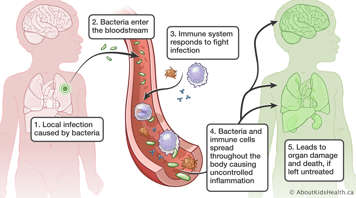What causes sepsis?
Sepsis is most often caused by bacteria. Some common bacterial causes include Staphylococcus aureus, various types of Streptococcus species and E. coli. Sepsis can also be caused by viral or fungal infections. Sometimes the specific infection and source of sepsis is not found.
Bacteria cause local infections such as pneumonia, urinary tract infections and infections of the gastrointestinal tract or skin. If bacteria from these infections enter the bloodstream, the infection can spread to the rest of the body. This forces the body’s immune system to generate a strong immune response to fight the infection.
The strong immune response, along with the bacteria already in the body, creates inflammation. This inflammation damages tissue and interferes with blood flow. The change in blood flow can lead to a dangerous drop in blood pressure, which stops oxygen from reaching the body’s organs and tissues. This series of events is known as sepsis.
Who can develop sepsis?
Any child with an infection can develop sepsis. However, there is a higher risk for certain populations, including the following:
- newborns and young infants
- children who have recently had surgery
- children with weakened immune systems, for example due to cancer or an organ transplant
- children with chronic (long-term) diseases, such as gastrointestinal conditions or kidney disease
Some medications, such as steroids used over a long time and other forms of chemotherapy, can also put children at higher risk of developing sepsis.
